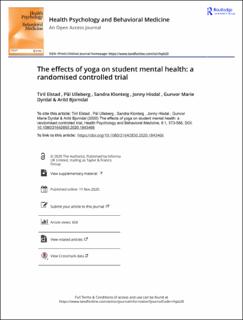| dc.contributor.author | Elstad, Tiril | |
| dc.contributor.author | Ulleberg, Pål | |
| dc.contributor.author | Klonteig, Sandra | |
| dc.contributor.author | Hisdal, Jonny | |
| dc.contributor.author | Dyrdal, Gunvor Marie | |
| dc.contributor.author | Bjørndal, Arild | |
| dc.date.accessioned | 2021-02-01T14:07:22Z | |
| dc.date.available | 2021-02-01T14:07:22Z | |
| dc.date.created | 2020-11-20T12:50:21Z | |
| dc.date.issued | 2020 | |
| dc.identifier.citation | Health Psychology and Behavioral Medicine. 2020, 8 (1), 573-585. | en_US |
| dc.identifier.issn | 2164-2850 | |
| dc.identifier.uri | https://hdl.handle.net/11250/2725627 | |
| dc.description.abstract | Background
Universities around the world are facing an epidemic of mental distress among their students. The problem is truly a public health issue, affecting many and with serious consequences. The global burden of disease-agenda calls for effective interventions with lasting effects that have the potential to improve the mental health of young adults. In this study we aimed to determine whether yoga, a popular and widely available mind-body practice, can improve student mental health.
Methods
We performed a randomised controlled trial with 202 healthy university students in the Oslo area. The participants were assigned to a yoga group or waitlist control group in a 1:1 ratio by a simple online randomisation program. The intervention group was offered 24 yoga sessions over 12 weeks. Measurements were taken at week 0 (baseline), week 12 (post-intervention), and week 24 (follow-up). The primary outcome was psychological distress assessed by the HSCL-25 questionnaire. Analysis was performed based on the intention to treat-principle.
Results
Between 24 January 2017, and 27 August 2017, we randomly assigned 202 students to a yoga intervention group (n = 100), or waitlist control group (n = 102). Compared with the control group, the yoga participants demonstrated a significant reduction in distress symptoms both at post-intervention (adjusted difference in the mean change −0.15, 95% CI −0.26 to −0.03, p = 0.0110) and follow-up (adjusted difference in the mean change −0.18, 95% CI −0.29 to −0.06, p = 0.0025). Sleep quality also improved at post-intervention and follow-up. No adverse events were reported.
Conclusions
Our findings suggest that yoga has a moderately large and lasting effect, at least for some months, reducing symptoms of distress and improving sleep quality among students. Further research should seek ways to enhance the effect, assess an even longer follow-up period, include active control groups, and consider performing similar studies in other cultural settings. | en_US |
| dc.language.iso | eng | en_US |
| dc.publisher | Taylor & Francis Open Access | en_US |
| dc.rights | Navngivelse 4.0 Internasjonal | * |
| dc.rights.uri | http://creativecommons.org/licenses/by/4.0/deed.no | * |
| dc.title | The effects of yoga on student mental health: a randomised controlled trial | en_US |
| dc.type | Peer reviewed | en_US |
| dc.type | Journal article | en_US |
| dc.description.version | publishedVersion | en_US |
| dc.source.pagenumber | 573-585 | en_US |
| dc.source.volume | 8 | en_US |
| dc.source.journal | Health Psychology and Behavioral Medicine | en_US |
| dc.source.issue | 1 | en_US |
| dc.identifier.doi | 10.1080/21642850.2020.1843466 | |
| dc.identifier.cristin | 1850392 | |
| dc.description.localcode | © 2020 The Author(s). Published by Informa UK Limited, trading as Taylor & Francis Group This is an Open Access article distributed under the terms of the Creative Commons Attribution License (http://creativecommons.org/ licenses/by/4.0/), which permits unrestricted use, distribution, and reproduction in any medium, provided the original work is properly cited. | en_US |
| cristin.ispublished | true | |
| cristin.fulltext | original | |
| cristin.qualitycode | 1 | |

